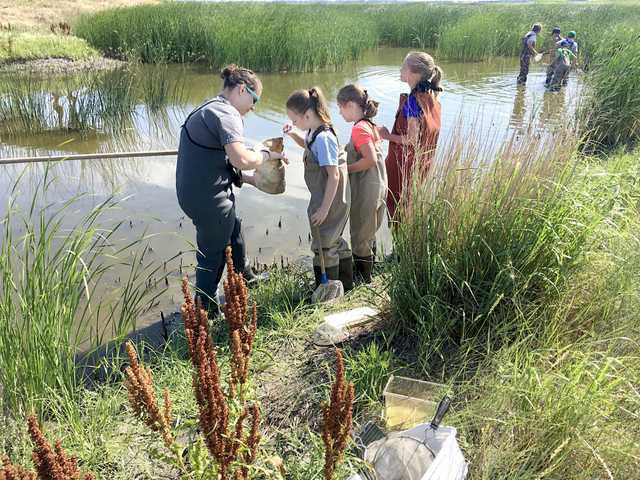The Wetland Explorer – Because No One Remembers Their Best Day of Television

This article appeared in the Great Bend Tribune on June 30, 2018 as part of the monthly KWEC column, The Wetland Explorer.
In the United States, children ages 5 to 16 spend about 45 hours a week looking at a TV or computer monitor. That adds up to three months out of the year our kids are staring at a screen. In fact, tweens are spending less time outside than the average prisoner. Most parents admit that their kids spend less time outside than they did as kids. Curtis Wolf shared about this phenomenon termed Nature Deficit Disorder in a past Wetland Explorer article. But it is not too late! It is easy to get kids outside experiencing natural wonders and it can often be free as well!
In my first month as a program specialist at the Kansas Wetlands Education Center, I have seen firsthand how excited kids can be about getting outside and exploring the hidden wonders of our wetlands. I watched as two timid girls, campers with the Great Bend Rec Aquatic Day Camp, were hesitant to wade into the depths of the marsh in search of benthic macroinvertebrates (bottom dwelling organisms with an exoskeleton). As we started to find damsel fly nymphs, water boatman, orange-spotted sunfish and bullfrog tadpoles with varying leg size and number, the girls became more excited about the hidden aquatic life and developed a zest to find more. They wanted to take the lead on hunting locations and sweeping the nets and seines through the water. Later their eyes lit up as we examined the specimens under magnifying glasses and document cameras, using identification charts to name what they found. Imagine if they had spent their day binging Netflix.
Learn to embrace nature where you are. Your family does not have to plan a trip to one of the 388 U.S. National Parks. Create a world-watching window in your living room. Stock it with a nature notebook, stargazing guide, or bird identification book. Plan a picnic in the park and create a nature collection complete with acorns, leaves, snail shells, and pinecones. Look for fossils in a road cut, pitch a tent in your backyard, or look for animal tracks on a pond bank.
Don’t let your kids become a statistic this summer and kick them outside to explore the wonders of Kansas nature. A good place to get started is to check out the Kansas Wildlifer challenge at http://kansaswildlifer.com/. Sponsored by the Kansas Wildscape Foundation, kids complete challenges like catching a firefly, holding a frog, climbing a tree and swimming in a lake. Beyond the rewards the outdoors give you, there are even prizes awarded to participants.
Or make plans to attend upcoming KWEC events. On Aug. 10 we will turn to the night sky during one of the brighter meteor showers of the year, the Perseids. And the always-popular Butterfly Festival on Sept. 15 is a chance to learn about attracting butterflies to your yard and to tag monarch butterflies to be tracked on their annual southward migration. Keep nature-deficit at bay and get outside to play!
Mandy Kern is a program specialist at the Kansas Wetlands Education Center, 592 North East K-156. Contact her at amkern2@fhsu.edu or call the KWEC’s toll-free telephone number, 877-243-9268.